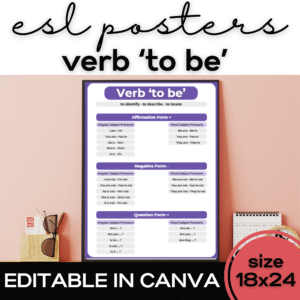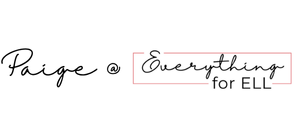If you teach beginner ESL, chances are the verb to be is one of the first grammar points you introduce. And while it seems super simple, it is one of the most essential verbs your students will need to learn. Side note: it shouldn’t be the first thing you introduce, so if your curriculum has you starting there, check out which concepts students need before tackling the verb to be.
So, what are the common mistakes, why do they happen, and how do we avoid them? Let’s break it down.
Mistake #1: Not Using the Verb To Be 🚧
Looks like: He tall instead of He is tall.
Why it happens: In a lot of romantic languages like Spanish, French, and Portuguese, the subject pronoun it doesn’t always exist in isolation, but rather it is implied through the conjugation of the verb. Additionally, am/is/are are small little words, and some students drop them because they are focused on new vocabulary more than the verb.
🛠️ The fix: Teach the subject pronoun and verb together. Often time teachers will say, “I…” and wait for students to respond, “am.” Over the years, I have shifted away from this, and now I say, “I am…” and wait for students to respond with the correct vocabulary words. Listening this way creates that pathway in the brain that “I am” is a unit versus “I” and “am” being separate units put together. Do this with “you are,” “he/she/it is,” and “they/we are.”
Mistake #2: Using He and She instead of It 🚧
Looks like: She is a pencil. He is a book.
Why it happens: In Arabic and Pashto, it doesn’t exist as a non-gendered pronoun, so a gendered pronoun is used in its place. Other languages, like Turkish, lump he, she, and it into one pronoun. It takes students a while to wrap their minds around the concept that it is used for an inanimate object only.
🛠️ The fix: Teach it in isolation. Teaching it without adding in he, she establishes that in English, it functions independently as a non-gendered pronoun. It is pairs nicely with classroom objects, and that vocabulary can open up an ESL student’s world as they need the vocabulary of notebook, pencil, pen, and backpack in their daily school routine.
Mistake #3: Using an incorrect Verb To Be 🚧
Looks like: I is a student. They am happy.
Why it happens: Students are still learning subject-verb agreement, and English doesn’t make it easy with six pronouns taking three possible verbs: am, is, are.
🛠️ The fix: We know that high school and adult learners don’t learn language naturally at this age, but rather they learn intentionally. As language teachers, we need to be intentional as well. I teach the verb to be in this order:
- I am + nationalities first. This gives the ESL student a way to begin to describe themselves.
- It is + classroom objects. Again, this solidifies that it is used in English for inanimate objects.
- He/She is + jobs. This solidifies that he and she are used for genders.
- We are/ They are + jobs. This solidifies the concept of plurality using people.
Only until students seem really confident with each language unit (I am, She is, It is, We are), do we begin to mix the subject pronouns.
I also use an anchor chart to help my visual learners, and if you think anchor charts are for elementary students, please think again. Our high school and adult learners thrive with visuals and are also independent learners. My teens walk up to anchor charts often to check their answers and understanding, leaving me a moment to sip my lukewarm coffee.
Some Pro Tips on Teaching the Verb To Be
💡 If you find that adding job vocabulary is too overwhelming for your students, follow I am + nationalities with He/She is + nationalities before moving on to We are/ They are + jobs. I have done this in the past with groups of students who require more time to retain language.
💡 Another common stumbling block is going from subject pronouns to names ie: She to Susan. Students often don’t know if Susan is female or an object. For this reason, I try to use names from my students’ cultures to help out. Don’t stress about this too much. You have the opportunity to clean this up again when you teach have/has and the simple present tense.
💡Don’t jump into worksheets. It’s important to teach to be in a way that highlights its function in English and allows it to begin building true fluency. Use a lot of realistic visuals, and use a call-and-response style of teaching so students hear and speak the units of language correctly.
Looking for related resources? Check out these:
Verb To Be; Not To Be Is Not an Option
I had to squeeze the Shakespeare reference in here somewhere. I am both sorry and not sorry.
Look, mastering to be gives your ESL students a foundation that supports everything that comes later. So, take your time. I usually take three weeks. If your district has you on a rigid, fast language learning timeline, burn it.🔥I said what I said.
Teach it in chunks, teach it with visuals, teach it with a lot of auditory input and speaking output. I promise, you and the students will be just fine.
👉 Want to spend 3 weeks on To Be? Grab my $7 Unit!
OR try it before you buy it!
Grab my FREE 2 lessons below! 👇
















